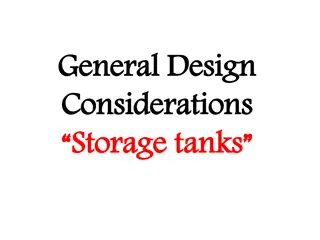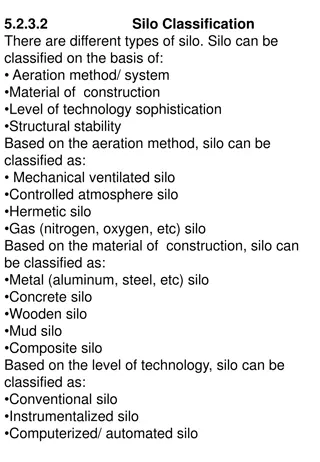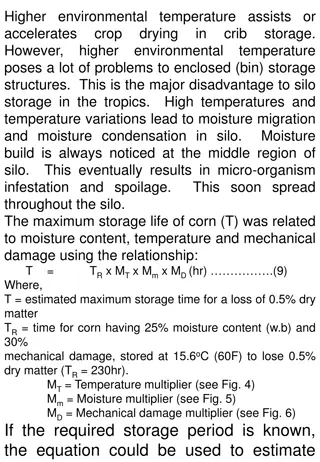Understanding Silo Design and Storage Systems
Silos are cylindrical structures used for bulk storage of shelled grains, but moisture condensation poses challenges. Proper design factors like system capacity, location, handling methods, and structural requirements are crucial for efficient storage. Accessories like material handling equipment and drying operations are essential for maintenance. Learn how to overcome moisture issues in silo storage and optimize grain preservation in this comprehensive guide.
Download Presentation

Please find below an Image/Link to download the presentation.
The content on the website is provided AS IS for your information and personal use only. It may not be sold, licensed, or shared on other websites without obtaining consent from the author. Download presentation by click this link. If you encounter any issues during the download, it is possible that the publisher has removed the file from their server.
E N D
Presentation Transcript
5.2.3 Silo/ Bin Silo is a cylindrically shaped structure used for bulk storage of shelled grains in large scale and for long term. Moisture condensation are major problems of silo. Hence, the need for accessories such as material handling and drying operation and maintenance of silo require high level of skill & technicalities. Silo is used for bulk grain storage. It is used as a large scale and long term storage. Silo is known to effectively store grains in the temperate regions for decades. Most silos are cylindrical in shape and constructed of metal, aluminum, rubber or concrete. Moisture migration and moisture condensation are the major problems militating against the use of silo storage in the tropics. Approaches to solve these problems include the provision of auger agitator and dryer; using of nitrogen atmosphere, airtight, and the introduction of insulations. Material handling equipments are accessories to silo storage. Silo is very costly. Some of them are monitored by computers. migration and equipments. Design,
5.2.3.1 In designing storage bin the following factors must be given careful consideration: System capacity Location and orientation of bin Handling method and equipments Structural requirements (i) System Capacity: It is necessary to know the tonnage or capacity of the system. It is therefore, required to know the quantity of grain to be stored and the number of bins to be used. The farmer should decide either to have a single bin with a large capacity or have several small bins. In most cases the advantages of using smaller bins override the use of single bin. Grains can be changed from one bin to the other to prevent caking and deterioration. The use of smaller bins provides flexibility and future adaptations. (ii) Location and Orientation of Bin This has a major influence on the efficiency of the system. The location will depend on the end use of the stored grains. Location of bin should be done such that excessive handling is minimized. Bins should be installed or constructed on solid foundations. The site must be accessible even during the rainy periods. Factors Considered in Silo Design
There must be adequate supply of power. Storage bin should be sited at about 60m away from residence because of the noise produced by the dryer and handling equipment. Orientation of the bin in relation to wind and storm must be proper. Bin should be located on a well drained land to avoid flooding. Otherwise, the bin should be located on elevated foundation. (iii) Handling Method & Equipment Bin storage basically requires material handling equipments especially conveyors. These equipments are used in loading and off-loading. Screw conveyors and belt conveyors are especially required. Bins are usually loaded from the top and off-loaded from the bottom. Handling equipment could either be portable or permanent. However, equipments should be eliminated to minimize cost. (iv) Structural Requirements: Storage bin should be able to withstand the various forces acting on it. Bin could have rectangular or circular cross-section but circular bins are preferable because of the lack of corner effect. Storage structures are classified either as deep bins or shallow bins. Generally, shallow bin is the one which has a depth less than the least lateral dimension of the bin while a deep bin has a depth greater than the least lateral dimension. Janssen, 1878, studied the pressures in deep bins and established the following relationship: P = ohLdh .. (1) Fv = (2) L (wR/ ) excessive handling = ohLdh (1 e-k h/R)
Where, for a consistent system of units L = w = = R = k = h = consideration Fv = P = Janssen assumed that k was constant throughout the grain mass in the bin under consideration. Also, for deep bins, the vertical pressure (v) on the floor is determined by the ratio of L & k. Thus, if L is determined for a maximum depth, h, the floor land, V, per unit area is given by V = L . . (4) k Note that k = 1 + sin where is the angle of internal friction. Mostly 0.3 k 0.6 Rankine developed the relationship for the pressure in shallow bins. Airy also developed similar equation but Rankine s equation is widely accepted. Rankine s equation for shallow bins: L = whk .. (6) The terms are as defined in (3) Airy s equation for shallow bins: Lateral pressure Grain specific weight Coeff of friction b/w grain and bin wall area of bin floor divided by the perimeter ratio of lateral o vertical pressure in grain Depth of grain to point under Vertical wall load per unit perimeter Total lateral wall load per unit perimeter 1 sin .. (5)























